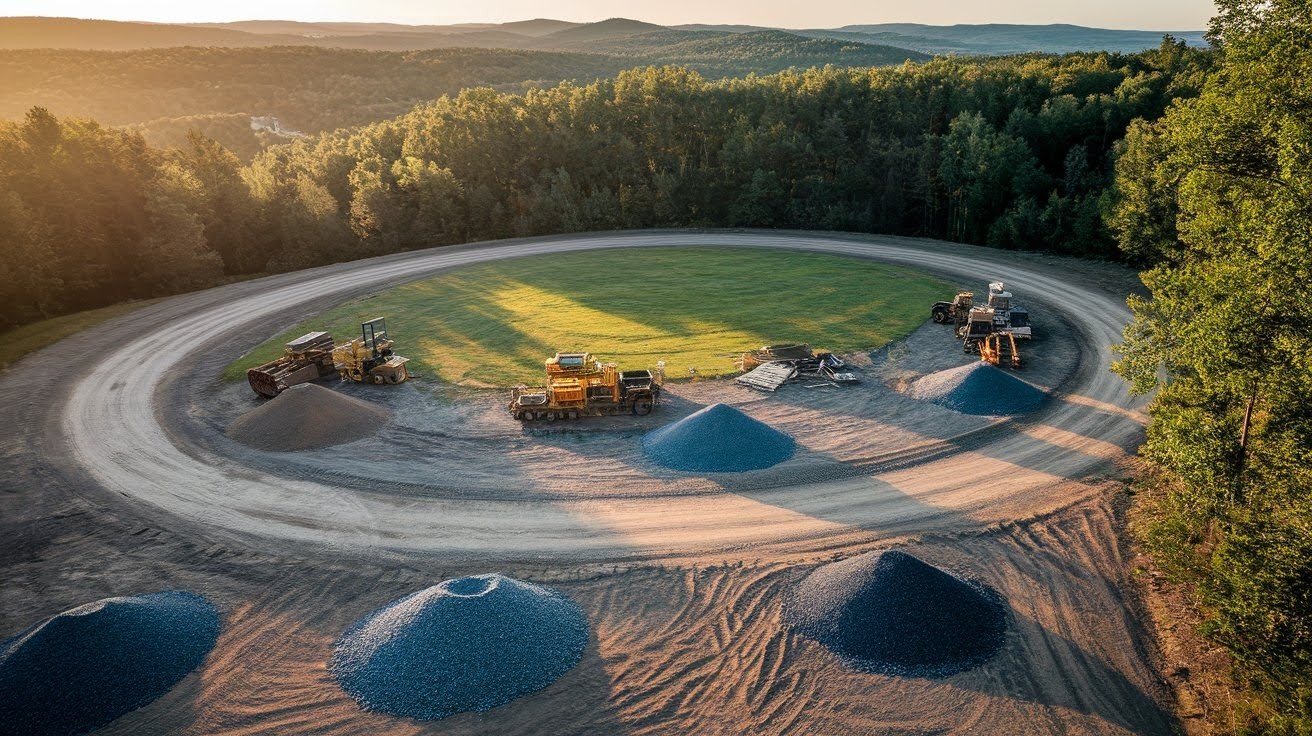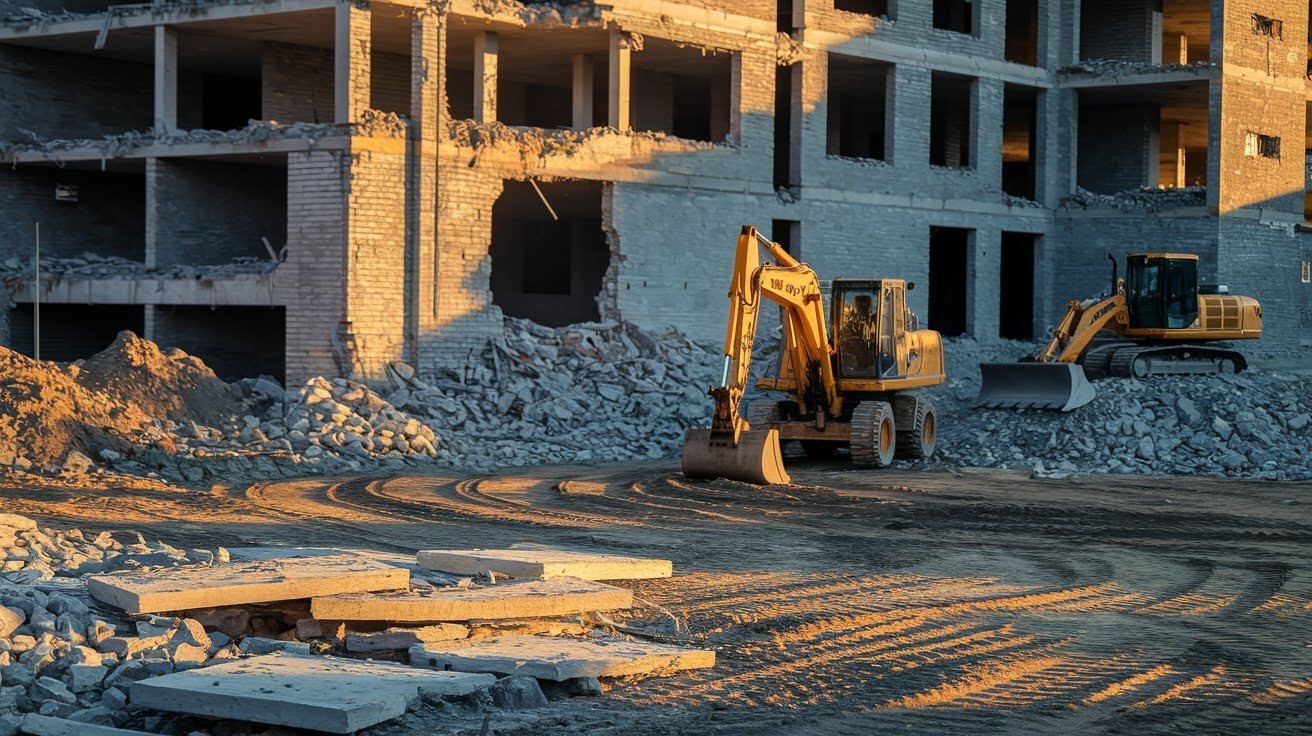While most people take the cost of building a house into account when making their budget, preparing the lot can make or break their construction budget. Preparing your lot to build a new home on it is more than just cutting down the trees and brush.
Preparing a site for a house costs from $10,000 to $50,000 or more. A flat cleared lot served by utilities costs less than a hillside wooded lot needing clearing and excavation, and extensions of water power and sewer lines.
This guide breaks down all the costs involved. These include tree removal and utility connections. It explains how to budget appropriately and account for price variations based on your location and situation.
Land Preparation Cost Breakdown: What You’re Actually Paying For
Let’s look at where your money actually goes during site preparation.
Clearing and Vegetation Removal Costs
Removing trees, grinding stumps, and hauling away debris is usually your first major expense. Expect to spend $3,000-$15,000 depending on how many trees you’re dealing with and how dense the vegetation is.
Tree removal costs vary wildly based on size and access. A few small trees might only cost $500 each, while mature oaks or pines can run $1,500 $3,000 per tree. Stump grinding adds another $100-$400 per stump, depending on diameter.
The total depends on your lot size and how much clearing is actually necessary. Some homeowners clear entire acres, while others strategically remove only what’s needed for the house pad and driveway, saving mature trees as natural landscaping.
Grading and Earthmoving Expenses
Creating a level building pad and proper drainage is critical work that costs $5,000-$30,000 for standard sites. Complex topography with significant elevation changes can push this to $10,000-$70,000 or more.
Grading involves cutting into hillsides, filling low spots, and sculpting the land so water flows away from your foundation. Simple lots might only need a few days of bulldozer work. Steep sites require extensive cut-and-fill operations with precise engineering.
The best scenario is when contractors can redistribute dirt on-site rather than hauling it away or bringing in new fill. Balanced earthwork saves thousands, but it requires enough space to work and suitable soil quality.
Soil Hauling and Fill Dirt Costs
When you can’t balance earthwork on-site, hauling becomes necessary at roughly $150 per truckload. This includes both removing excess dirt and bringing in quality fill when needed.
Hauling costs add up fast. Some projects require 40 or more truckloads, especially when dealing with unsuitable soil that must be excavated and replaced with compacted fill. Distance to the nearest dump site or fill source also impacts pricing.
You’ll need hauling when your site has too much material, too little, or poor-quality soil that won’t compact properly. Rocky terrain often requires removing stone and bringing in workable fill dirt.
Utility Installation and Connection Fees
Getting power, water, and waste systems to your site represents a major portion of the cost to prepare land for building a house. Well installation typically runs around $6,500, while septic systems average $6,500 as well.
Electrical service connections vary dramatically. If power lines reach your property, the hookup might be free or cost under $1,000. Need a transformer or must extend lines 500+ feet? You’re looking at $2,000-$10,0,00 or more.
Rural properties face the steepest utility costs. Running water or gas lines, extending sewer connections, or installing longer electric service can easily cost $10,000-$50,000, depending on distance. Always get utility quotes before buying land.
Site Access and Temporary Road Creation
Construction vehicles need solid access from day one. Building temporary driveways and maintaining them throughout construction is an often-overlooked expense that affects your timeline and budget.
Heavy loads like concrete trucks and lumber deliveries require stable roads that won’t turn to mud or develop ruts. You might spend $3,000-$10,000 creating and maintaining temporary access, depending on distance and soil conditions.
Some sites need gravel laid down immediately, while others require more extensive roadwork, including culverts for drainage. Remote lots with long driveways see higher costs, especially in wet climates where roads deteriorate during construction.
Key Factors That Affect Land Preparation Costs
Several site characteristics dramatically impact what you’ll spend getting land ready.
Lot Slope and Topography

Flat lots are substantially cheaper to prepare than sloped ones. Gentle slopes might only add a few thousand dollars, but steep hillsides can double or triple your site prep budget.
Working on steep terrain requires more equipment time, specialized machinery, and often retaining walls or extensive grading. Contractors must carefully engineer cuts and fills to create stable building pads without creating drainage problems.
Hillside sites look appealing but come with hidden costs. What seems like a minor slope might require moving hundreds of cubic yards of earth to create a level foundation area and proper access.
Lot Size and Acreage

One-acre lots give contractors room to redistribute soil efficiently, often lowering costs compared to cramped quarter-acre parcels. Larger properties (2+ acres) provide even more flexibility for balanced earthwork.
With adequate space, excavated material from one area can fill low spots elsewhere on your property. This eliminates hauling charges and speeds up the work. Tight lots force contractors to haul away excess dirt at significant expense.
However, larger wooded lots mean more clearing costs. The sweet spot is often a 1-2-acre partially cleared property with enough working room for equipment but not excessive vegetation removal.
Existing Site Conditions

Wooded land costs more to clear than open fields, sometimes by $10,000 or more. Rock outcroppings, large boulders, or ledges require expensive blasting or specialized equipment. Poor drainage areas need correction before building.
Soil composition matters tremendously. Sandy or loamy soil is easy to work with, while heavy clay or wet soils create challenges. Rocky terrain slows progress and may require removing stone before proper grading.
Protected wetlands or environmental restrictions can limit where you build or require special permits. Always check for these issues before buying land, as they can add unexpected costs or even make building impossible.
Location and Accessibility

Urban and suburban lots typically have easier access to utilities and materials, reducing the cost to prepare land for building a house. Rural properties often face premium charges due to distance from services and suppliers.
Remote sites mean contractors charge travel time, equipment transport costs more, and material delivery fees increase. If your property is 45 minutes from town, expect to pay for that inconvenience throughout the project.
Difficult access for heavy machinery also drives costs up. If excavators and bulldozers can’t easily reach your site, contractors must use smaller equipment or create access routes first, both expensive propositions.
Demolition Requirements

Existing structures need removal before site prep begins. Demolishing a house costs $10,000 $25,000 typically, depending on size and materials. This includes hauling debris to proper disposal facilities.
Old foundations, concrete slabs, or buried structures add complexity and expense. Concrete removal requires breaking it up and hauling away heavy material. Some sites have unexpected underground tanks or utilities requiring careful removal.
Site cleanup after demolition is essential before grading can begin. All debris must be removed, and the area must be cleared to bare ground for proper assessment and preparation work.
Additional Site Preparation Expenses to Budget For
Beyond the obvious costs, several other expenses impact your total site preparation budget.
Soil Testing and Geotechnical Reports
Most lenders and local codes require soil testing before construction. Professional geotechnical reports cost $5,000 to $20,000, depending on site complexity and how many test borings are needed.
These tests reveal soil bearing capacity, groundwater levels, and whether your site needs special foundation considerations. Poor soil might require deep footings, soil stabilization, or even engineered fill, adding thousands to your foundation costs.
Testing seems expensive until you consider the alternative of discovering soil problems after construction begins. That scenario can cost tens of thousands to fix and delay your entire project by months.
Permits and Regulatory Requirements
Local permits for site work, erosion control, and tree removal vary widely by region. Budget $500-$5,000 for various permits, inspections, and required erosion control measures like silt fencing.
Many municipalities have strict tree protection ordinances, especially for mature or heritage trees. Some require environmental assessments or wetland delineation studies before any site work begins.
Erosion control isn’t optional it’s legally required in most areas. Installing silt fences, stabilizing slopes, and managing runoff properly prevents fines and keeps your project compliant with environmental regulations.
Seasonal Considerations and Weather
Late spring through early fall offers the best conditions for site work in most regions. Ground is dry, equipment operates efficiently, and work proceeds quickly, keeping costs down.
Winter construction faces challenges like frozen ground, mud from snow melt, and limited working hours due to short days. Cold-weather work often costs 10-20% more and takes longer to complete.
Weather delays are inevitable and impact budgets indirectly. Extended rain periods halt work, but you’re still paying for equipment rental and contractor availability. Building in weather contingency time helps manage expectations and costs.
Common Land Preparation Mistakes to Avoid
Smart planning prevents expensive problems during site preparation and construction. Here are the most critical mistakes homeowners make:
- Underestimating total costs by 30-50%: Always add a contingency buffer to your site prep budget, as unexpected issues like rock or poor soil are common discoveries once excavation begins.
- Skipping comprehensive soil testing: Spending $5,000 on testing upfront prevents $30,000+ in foundation repairs later when you discover unsuitable soil conditions after building has started.
- Poor drainage planning around the building pad: Water must flow away from your foundation in all directions fixing drainage problems after construction is ten times more expensive than doing it right initially.
- Inadequate site access during the build phase: Undersized or poorly maintained construction roads create delays when concrete trucks get stuck or material deliveries can’t reach your site.
- Not verifying utility locations and costs early: Contact utility companies during land shopping, not after purchase learning that power lines must extend 1,200 feet at your expense changes everything.
- Overlooking local permit requirements and lead times: Some permits take 6-8 weeks to obtain starting site work without proper permits results in stop-work orders and fines.
- Clearing more vegetation than necessary: Trees provide natural privacy, shade, and erosion control removing them all costs more upfront and creates expensive landscaping needs later.
- Failing to coordinate site prep with builder timelines: Prepared sites deteriorate if left sitting for months coordinate closely so your lot is ready when construction actually begins.
- Not getting multiple detailed quotes from site contractors: Quotes that seem identical often include a very different scope of work compare line-by-line to understand what each contractor actually includes.
Conclusion
Knowing how much land preparation will cost you to build a house gives you the best chance of preparing a realistic budget from day one. Preparing a site typically costs from $10K to $50K or more, based on the site. Without a proper base, the entire build fails.
These costs should not deter you. You can still build your dream home. Use what you’ve learned here to help choose a property before buying. The cheapest land is usually the most expensive to prepare.
Preliminary plans, adequate soil tests, and hiring contractors who are experienced in site investigation can save you money in the long run, but the cost of pre-construction should be balanced against the higher cost of repairs if site work is poorly done.
Frequently Asked Questions
What is the average cost to prepare land for building a house?
Most homeowners spend $15,000 to $35,000 for site preparation on average lots with moderate clearing needs. Flat cleared land with nearby utilities costs $10,000 to $20,000, while complex wooded or sloped sites can exceed $60,000 depending on conditions.
Can I prepare the land myself to save money?
Small clearing tasks like brush removal are possible DIY projects, but grading, utility installation, and excavation require licensed professionals with proper equipment and insurance. Improper site work creates expensive drainage and foundation problems that cost far more to fix.
How long does land preparation take before building?
Simple sites take 1-3 weeks for preparation, while complex properties need 4-8 weeks or longer. Timeline depends on clearing requirements, grading complexity, utility installations, weather conditions, and permit approval processes.
Do I need permits for land preparation work?
Yes, most municipalities require permits for grading, tree removal, utility connections, and erosion control. Permit requirements vary by location and scope of work. Contact your local building department early to understand specific requirements and avoid delays or fines.
What increases land preparation costs the most?
Distance from utilities, steep slopes, extensive tree removal, poor soil requiring hauling, and rock excavation are the biggest cost drivers. The cost to prepare land for building a house increases significantly when multiple challenging conditions exist on one property simultaneously.


